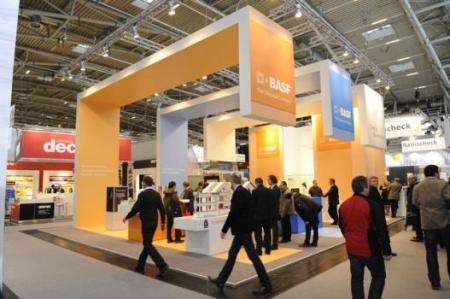Jan 16 2013
BASF is to showcase chemistry's contribution to sustainable construction at the BAU 2013 trade fair in Munich from January 14 - 19, 2013. Based at Hall A4/stand 303, the company presents numerous solutions, including products to raise the energy efficiency of buildings. Other exhibits include materials to make buildings more durable and in that way reduce maintenance and repair. BASF also supports architects and planners keen to try out new design approaches, and presents insights into the latest research on electrochromic pigments for ambient interior lighting.
 BASF is to showcase chemistry's contribution to sustainable construction at the BAU 2013 trade fair in Munich.
BASF is to showcase chemistry's contribution to sustainable construction at the BAU 2013 trade fair in Munich.
BASF is partnering the special show Sustainable construction: a transparent guide to the appropriate product hosted by the German Sustainable Building Council (DGNB). In two presentations on life cycle assessment of concrete, a BASF expert will outline the impact of more sustainable concrete on established building certification systems. The presentations take place on Friday, January 18, and Saturday, January 19, from 1:00 p.m. to 1:20 p.m. at the DGNB stand located in Hall C2/311.
"Our goal is to integrate sustainability into our business even more than before. We understand sustainable construction to be a process that combines economic viability, conservation of resources, environment protection and addresses social needs. Chemical innovations are the key to sustainable building," commented BASF manager Jacques Delmoitiez, whose responsibilities for business in the Europe, Middle East and Africa region include promoting dialog between the construction industry and BASF.
The construction industry is one of BASF’s key customer industries, accounting for five to ten percent of total sales.
Improving the energy footprint of buildings
One aim of the dialogue process is to help develop solutions for more energy-efficient buildings. The construction and housing area accounts for approximately 40 percent of global energy consumption and 30 percent of global CO2 emissions. This impact can be reduced significantly. The range of solutions BASF presents at BAU includes perimeter insulation, window frames with reduced thermal bridges, and insulating systems for frontage, roofs and solar collectors.
Neopor ® , an advanced version based on the classic polystyrene insulation material Styropor ® , contains special graphite particles that reflect thermal radiation like a mirror and reduce heat loss in the home. The technology is shown in use in a flat roof and in a system with rear-ventilated rainscreen cladding. Long-established S tyrodur® C is ideal for perimeter insulation because of its high compressive strength and low water absorption. These two properties are highlighted in the trade fair presentation. Basotect ® , an open-cell specialty foam made from melamine resin, is a heat-resistant thermal insulator used for applications such as insulating solar collectors.
More solutions that contribute to energy efficiency include polyurethane applications. BASF's BAU exhibits include tried and tested Elastopor® and Elastopir® rigid polyurethane foam boards for insulating roofs, walls, floors and ceilings and PU sandwich elements for roofs and facades. With features including ultra-low thermal conductivity (grade 024), these materials are also used for rigid polyurethane foam insulation systems for window frames and window blinds.
Minimizing maintenance and repair effort
BASF materials also help to protect structures from weathering, in that way reducing maintenance and repair work. The company's exhibits include roof linings with a thermoplastic polyurethane layer to protect roofs from the elements.
Better acoustics for added comfort
Visitors interested in enhancing comfort levels in residential, commercial and industrial buildings are advised to try out the acoustics box on the BASF stand. Again, Basotect comes into play. The versatile specialty foam with its extensive range of properties absorbs sound for measurably improved acoustics.
Enhanced design options
And finally, BASF materials open up a wealth of design possibilities: Permaskin ®, an innovative thermoplastic polyurethane coating for structured and three-dimensional building elements such as doors, shutters, cladding, paneling and garage doors enhances surface appearance with a huge variety of structures, enabling a range of designs from plain monochrome surfaces to wood-look finishes.
The exhibit highlighting the ambient lighting research project shows polyester films with electrochromic pigments applied to materials such as glass. The idea is that these pigments change color when voltage is applied via an integrated solar cell. In just a few years' time, the technology may be developed far enough for use in applications such as glass-paneled office doors.
The world's leading trade fair for architecture, materials and systems this year plays host to approximately 2,000 exhibitors from more than 40 countries. BASF has been exhibiting at the show for many years.